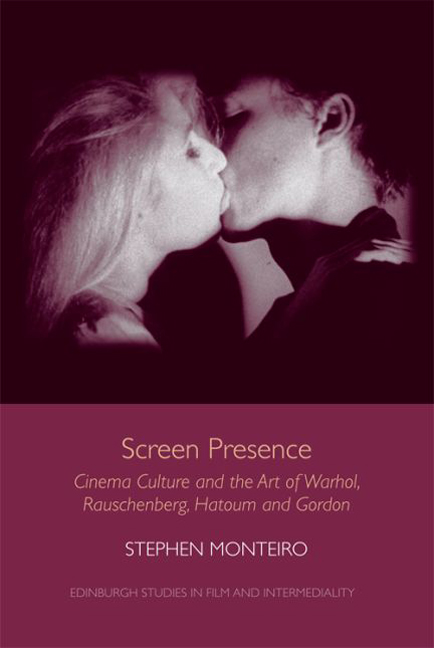Book contents
- Frontmatter
- Contents
- List of Figures
- Acknowledgements
- Introduction: Cinema's Grey Spaces
- 1 A Wider Audience: Robert Rauschenberg, the White Paintings and CinemaScope
- 2 The Screen Scene: Andy Warhol, the Factory and Home Movies
- 3 Private Dis-Pleasures: Mona Hatoum, Mediated Bodies and the Peep Show
- 4 A Monument in Ruins: Douglas Gordon, Screen Archaeology and the Drive-in
- Conclusion
- Index
3 - Private Dis-Pleasures: Mona Hatoum, Mediated Bodies and the Peep Show
Published online by Cambridge University Press: 15 September 2017
- Frontmatter
- Contents
- List of Figures
- Acknowledgements
- Introduction: Cinema's Grey Spaces
- 1 A Wider Audience: Robert Rauschenberg, the White Paintings and CinemaScope
- 2 The Screen Scene: Andy Warhol, the Factory and Home Movies
- 3 Private Dis-Pleasures: Mona Hatoum, Mediated Bodies and the Peep Show
- 4 A Monument in Ruins: Douglas Gordon, Screen Archaeology and the Drive-in
- Conclusion
- Index
Summary
The commercial viability of independent cinema at the start of the 1970s, heralded by the success of Dennis Hopper's Easy Rider (1969) as an example of what would be called ‘New Hollywood’, diminished the market for aesthetically unconventional soft- and hardcore films made by Warhol Films and others. Depictions of drug use, nudity and sex no longer attracted the vice squad, but qualified for Academy Award nominations and trophies. This turn obviated the need for an avant-garde moniker to facilitate distribution. As expanded-cinema groups such as the London Film-makers Cooperative tested the material and ontological limits of film and the cinema apparatus, a flood of low-budget genre films – from blood-and-guts exploitation films for drive-ins to hardcore pornographic features for dying urban theatres – capitalised on the recent dismantling of long-standing obscenity laws and censorship codes in North America and Western Europe. Following the increased availability and visibility of porn magazines in public places such as newsstands, pornographic films previously mail-ordered for home projection or viewed in unlicensed bars or clubs began to appear in more conspicuous public settings. New porn theatres (usually once-venerable single-screen movie theatres squeezed out of the first-run market by multiplex theatres) and storefront peep-show parlours sprang up in most North American and Western European cities, spreading to post-communist Eastern Europe in the 1990s. ‘To struggling [American theatre] owners, it seemed like a miracle when in 1969 the Production Code was repealed’, states Jack Stevenson, ‘There was suddenly easy money to be made screening porn.’ Urban areas previously known for other forms of legal and illegal entertainment – New York City's Times Square, Paris’ Pigalle, London's Soho – became centres of porn distribution and exhibition, providing consumers with rows of sex shops filled with magazines, books, films and live shows.
The principal formats for moving-image pornography – film and videotape – were increasingly absorbed into artistic practice during this period. In the 1970s and 1980s, video co-ops and collectives such as Videofreex in New York, Raindance and TVTV (Top Value Television) in California and TVX in London, developed alongside – or replaced – art-film groups. Like 8-mm and 16-mm film before it, consumer-grade video proved an inexpensive and effective weapon for challenging an ever-more pervasive mass-media culture.
- Type
- Chapter
- Information
- Screen PresenceCinema Culture and the Art of Warhol, Rauschenberg, Hatoum and Gordon, pp. 102 - 143Publisher: Edinburgh University PressPrint publication year: 2016



